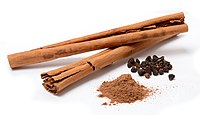
Effects of homogenization on the molecular flexibility and emulsifying properties of soy protein isolate
Sign Up to like & getrecommendations! Published in 2018 at "Food Science and Biotechnology"
DOI: 10.1007/s10068-018-0361-x
Abstract: The sensitivity of soy protein isolate (SPI) to trypsin was characterized by its flexibility. The effects of different homogenization conditions on soy protein isolate flexibility and emulsifying properties were investigated. Set the homogenization pressure was… read more here.
Keywords: flexibility emulsifying; soy protein; flexibility; emulsifying properties ... See more keywords

Cyanoflan: A cyanobacterial sulfated carbohydrate polymer with emulsifying properties.
Sign Up to like & getrecommendations! Published in 2020 at "Carbohydrate polymers"
DOI: 10.1016/j.carbpol.2019.115525
Abstract: The extracellular polysaccharides produced by cyanobacteria have distinctive characteristics that make them promising for applications ranging from bioremediation to biomedicine. In this study, a sulfated polysaccharide produced by a marine cyanobacterial strain and named cyanoflan… read more here.
Keywords: carbohydrate polymer; properties cyanoflan; emulsifying properties; cyanoflan cyanobacterial ... See more keywords

Monitoring of the functional properties and unfolding change of Ovalbumin after DHPM treatment by HDX and FTICR MS: Functionality and unfolding of Oval after DHPM by HDX and FTICR MS.
Sign Up to like & getrecommendations! Published in 2017 at "Food chemistry"
DOI: 10.1016/j.foodchem.2017.01.109
Abstract: Dynamic high-pressure microfluidizaiton (DHPM) induced unfolding of proteins and enzymes could enhance the functional properties and hydrolytic ability of the molecules. In this study, the effect of DHPM on the surface activities of Ovalbumin (Oval),… read more here.
Keywords: functional properties; foaming emulsifying; dhpm; emulsifying properties ... See more keywords

Effects of freeze-thaw cycles on the structure and emulsifying properties of peanut protein isolates.
Sign Up to like & getrecommendations! Published in 2020 at "Food chemistry"
DOI: 10.1016/j.foodchem.2020.127215
Abstract: This study investigated changes of the structure and emulsifying properties of peanut protein isolate (PPI) during multiple freeze-thaw (F-T) cycles. According to the Fourier transform infrared spectrum, the F-T treatment to PPI reduced the content… read more here.
Keywords: ppi; structure emulsifying; properties peanut; emulsifying properties ... See more keywords

Solubility and emulsifying properties of perilla protein isolate: Improvement by phosphorylation in the presence of sodium tripolyphosphate and sodium trimetaphosphate.
Sign Up to like & getrecommendations! Published in 2022 at "Food chemistry"
DOI: 10.1016/j.foodchem.2022.132252
Abstract: To investigate the mechanisms of phosphates affecting the solubility and emulsifying properties of perilla protein isolate (PPI), PPI was treated with sodium trimetaphosphate (STMP) and sodium tripolyphosphate (STPP) at different concentrations. FTIR and XPS showed… read more here.
Keywords: emulsifying properties; perilla protein; properties perilla; solubility emulsifying ... See more keywords

Effects of hydrolysis by xylanase on the emulsifying properties of Artemisia sphaerocephala Krasch. polysaccharide
Sign Up to like & getrecommendations! Published in 2018 at "Food Hydrocolloids"
DOI: 10.1016/j.foodhyd.2016.12.015
Abstract: Abstract In the present study, Artemisia sphaerocephala Krasch. polysaccharide (ASKP) and high-molecular-weight fractions (60P) were treated with xylanase to improve the emulsifying properties. Hydrolyzed ASKP and 60P were structurally characterized using analytical size-exclusion chromatography and… read more here.
Keywords: xylanase; emulsifying properties; artemisia sphaerocephala; hydrolysis ... See more keywords

Effects of ultrasound treatment on the physicochemical and emulsifying properties of proteins from scallops (Chlamys farreri)
Sign Up to like & getrecommendations! Published in 2019 at "Food Hydrocolloids"
DOI: 10.1016/j.foodhyd.2018.11.032
Abstract: Abstract In this study, different ultrasound powers, namely, 0, 200, 400, 600, 800 and 950 W with intensities of 0, 707.71, 1415.43, 2123.14, 2830.86 and 3361.64 W cm−2, respectively, were applied to treat proteins from scallops. Proteins from… read more here.
Keywords: effects ultrasound; ultrasound treatment; treatment; proteins scallops ... See more keywords

Emulsifying properties of wheat germ:Influence of pH and NaCl
Sign Up to like & getrecommendations! Published in 2020 at "Food Hydrocolloids"
DOI: 10.1016/j.foodhyd.2019.105431
Abstract: Abstract The emulsifying properties of wheat germ (WG) were evaluated as a function of WG concentration (1%, 2%, 4% and 8%, w/w), pH (3, 5, 7 and 10), NaCl content (0.5%, 1%, 3% and 5%,… read more here.
Keywords: concentration; droplet size; emulsion; emulsifying properties ... See more keywords

Towards recombinantly produced milk proteins: Physicochemical and emulsifying properties of engineered whey protein beta-lactoglobulin variants
Sign Up to like & getrecommendations! Published in 2021 at "Food Hydrocolloids"
DOI: 10.1016/j.foodhyd.2020.106132
Abstract: Two recombinant beta-lactoglobulin (BLG) B variants were produced in E. coli. Production/isolation resulted in native BLG without post-translational modifications. Properties of recombinant variants were compared to commercial BLG B and BLG AB. Minor differences in… read more here.
Keywords: produced milk; recombinantly produced; emulsifying properties; beta lactoglobulin ... See more keywords

Rheological, textural and emulsifying properties of an exopolysaccharide produced by Mesorhizobium loti grown on a crude glycerol-based medium.
Sign Up to like & getrecommendations! Published in 2018 at "International journal of biological macromolecules"
DOI: 10.1016/j.ijbiomac.2018.06.158
Abstract: In the present study, a new extracellular polysaccharide (EPS-M816) was obtained during the growth of Mesorhizobium loti Semia 816 on a crude glycerol-based medium. EPS-M816 precipitate mainly consisted of carbohydrates (82.54%) and proteins (11.31%), and… read more here.
Keywords: mesorhizobium loti; glycerol based; crude glycerol; emulsifying properties ... See more keywords

Influence of carboxymethylcellulose on the interaction between ovalbumin and tannic acid via noncovalent bonds and its effects on emulsifying properties
Sign Up to like & getrecommendations! Published in 2020 at "Lwt - Food Science and Technology"
DOI: 10.1016/j.lwt.2019.108778
Abstract: Abstract Ovalbumin (OVA) is widely used in the food industry due to its good emulsifying properties. However, polyphenols and polysaccharides in food may influence the interfacial properties of OVA. In our work, carboxymethylcellulose (CMC) and… read more here.
Keywords: tannic acid; emulsifying properties; carboxymethylcellulose interaction; influence carboxymethylcellulose ... See more keywords